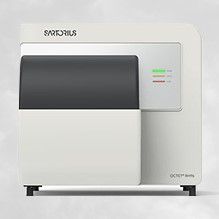96-Channel Ultra High Throughput Octet System: Octet
RH96 System

Point of Product
Benefits
1. Simultaneously reads 8, 16, 32, 48 or 96 wells
The RH96 read head provides design flexibility that allows users to analyze, 8, 16, 32, 48, or 96 samples at a time allowing for customized throughput up to 96 samples.
2. Full plate off-rate ranking in minutes, not hours
The Dip and Read assay format allows off-rate analysis of clones to be performed rapidly even in crude samples using ready-to-use biosensors off the shelf.
3. 96-well plate quantitation in as little as two minutes
IgG titer determination of a full 96-well plate can be completed in two minutes. In addition, sample plate compartment is compatible with 384-well plates allowing for even more throughput.
4. 32 x 32 epitope binning in less than eight hours
With the RH96, analysis of epitope binning matrices can be completed in record time, with 32 x 32 in less than eight hours. A powerful epitope binning analysis software enables easy visualization of data sets and provides a flexible data matrix that can accommodate a variety of cross-blocking formats.
5. Microfluidics-free Dip and Read format reduces assay time and maintenance
cost
The Octet RH96 utilizes Dip and Read™ technology with the read head dipping into samples in a plate format. With no fluidics involved, Octet systems are highly robust.
Applications
ELISA Conversion
ELISAs are known for having variability in results, susceptibility to human error, and slow times-to-results. High throughput Octet systems are designed to overcome those limitations. Convert your ELISA assay into an Octet assay.
Epitope Binning
Epitope binning studies rely on the sequential binding of two antibodies to an antigen, and are performed using dozens of antibody pairs in cross-competition matrices. The Octet system excels at these large-scale studies due to assay speed, throughput, and exceptional reproducibility
Protein Contaminant Testing
Protein contaminants are a major hurdle to overcome during the production of biopharmaceuticals. The Octet platform's rapid high throughput protein analysis combined with the anti-CHO HCP and Residual Protein A kits provide biologics developers with a rapid and easy to use technique for contaminant testing.
Specification
|
Technology
|
Bio-Layer
Interferometry (BLI) based on fiber optic biosensors
|
|
Sample
volume
|
40–80
μL/well (384-well tilted bottom microplate) and 180–220 μL/well (96-well
microplate), nondestructive testing, easily recovered
|
|
Data
presentation
|
Sensorgrams
displaying kinetic traces or concentration binding rates Epitope binning and
cross-blocking matrices and trace overlays Tabulated kinetic or concentration
data
|
|
Automation
|
Robot
compatible microplate and biosensor tray loading
|
|
Orbital
flow capacity
|
Static
or 100–1500 rpm
|
|
Analysis
temperature
|
Ambient
+ 4°C to 40°C, in 1°C increments
|
|
Association
rate constant (ka)
|
101 to 107 M-1 s-1 |
|
Dissociation
rate constant (kd)
|
10-6 to 10-1 s-1 |
|
Affinity
constant (KD)
|
1
mM – 10 pM
|
|
Baseline
noise (RMS)
|
<3
pm (8–16 biosensors); <8 pm (32–96 biosensors)
|
|
Baseline
drift
|
<
0.1 nm/hour
|
|
Quantitation
range
|
32–96
biosensors: 0.1–100 μg/mL of hIgG at 1000 rpm**; 1.0–700 μg/mL at 400 rpm 8–16
biosensors: 0.05–300 μg/mL of hIgG at 1000 rpm**; 0.5–2000 μg/mL at 400 rpm
|
|
Quantitation
precision
|
CV
<10%
|
|
Weight
|
200
lbs (90.7 kg)
|
|
Dimensions
(H x W x D)
|
30.1
in x 31.5 in x 31.5 in (77 cm x 80 cm x 80 cm)
|
|
Sample
type
|
Proteins,
antibodies, peptides, serum containing media (up to 25%), DMSO containing
buffers, virus-like particles, untreated cell culture supernatants and crude
cell lysates
|
|
Sample
plate
|
Standard,
96-well and 384-well, black, tilted bottom microplates
|
|
Molecular
weight detection
|
>150
Da (8–16 biosensors), >5000 Da (32–96 biosensors)
|
